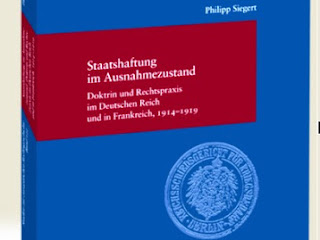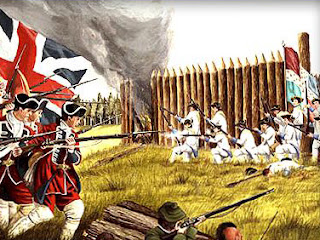[We have the following book announcement from our friends at Max Planck. DRE]
 The Max Planck Institute for European Legal History just published a new volume in its book series Studien zur europäischen Rechtsgeschichte: Philipp Siegert, Staatshaftung im Ausnahmezustand: Doktrin und Rechtspraxis im Deutschen Reich und in Frankreich, 1914-1919.
The Max Planck Institute for European Legal History just published a new volume in its book series Studien zur europäischen Rechtsgeschichte: Philipp Siegert, Staatshaftung im Ausnahmezustand: Doktrin und Rechtspraxis im Deutschen Reich und in Frankreich, 1914-1919.
The First World War is sometimes called the 20th century's "primordial catastophe." It raised diverse legal questions and led to a host of fundamental changes. In volume 322 of the MPIeR's book series Studien zur europäischen Rechtsgeschichte, which has just been published, Philipp Siegert examines state liability law in Germany and France between 1914 and 1918. On the basis of a detailed analysis of both French and German archival sources, he analyses states' legal responsibility during such a state of emergency and identifies categories of "legitimate" and "illegitimate" state action that, however, were either non-existent in pre-war international law or even contradicted it. Nevertheless, these were subsequently sanctioned by the peace treaties, and even a century after 1919 remain part of the international order. The ways in which destruction, expropriation and economic war measures carried out by France and Germany were assessed and sanctioned is highly instructive for the question of state liability in international law today.
 The Max Planck Institute for European Legal History just published a new volume in its book series Studien zur europäischen Rechtsgeschichte: Philipp Siegert, Staatshaftung im Ausnahmezustand: Doktrin und Rechtspraxis im Deutschen Reich und in Frankreich, 1914-1919.
The Max Planck Institute for European Legal History just published a new volume in its book series Studien zur europäischen Rechtsgeschichte: Philipp Siegert, Staatshaftung im Ausnahmezustand: Doktrin und Rechtspraxis im Deutschen Reich und in Frankreich, 1914-1919.The First World War is sometimes called the 20th century's "primordial catastophe." It raised diverse legal questions and led to a host of fundamental changes. In volume 322 of the MPIeR's book series Studien zur europäischen Rechtsgeschichte, which has just been published, Philipp Siegert examines state liability law in Germany and France between 1914 and 1918. On the basis of a detailed analysis of both French and German archival sources, he analyses states' legal responsibility during such a state of emergency and identifies categories of "legitimate" and "illegitimate" state action that, however, were either non-existent in pre-war international law or even contradicted it. Nevertheless, these were subsequently sanctioned by the peace treaties, and even a century after 1919 remain part of the international order. The ways in which destruction, expropriation and economic war measures carried out by France and Germany were assessed and sanctioned is highly instructive for the question of state liability in international law today.






